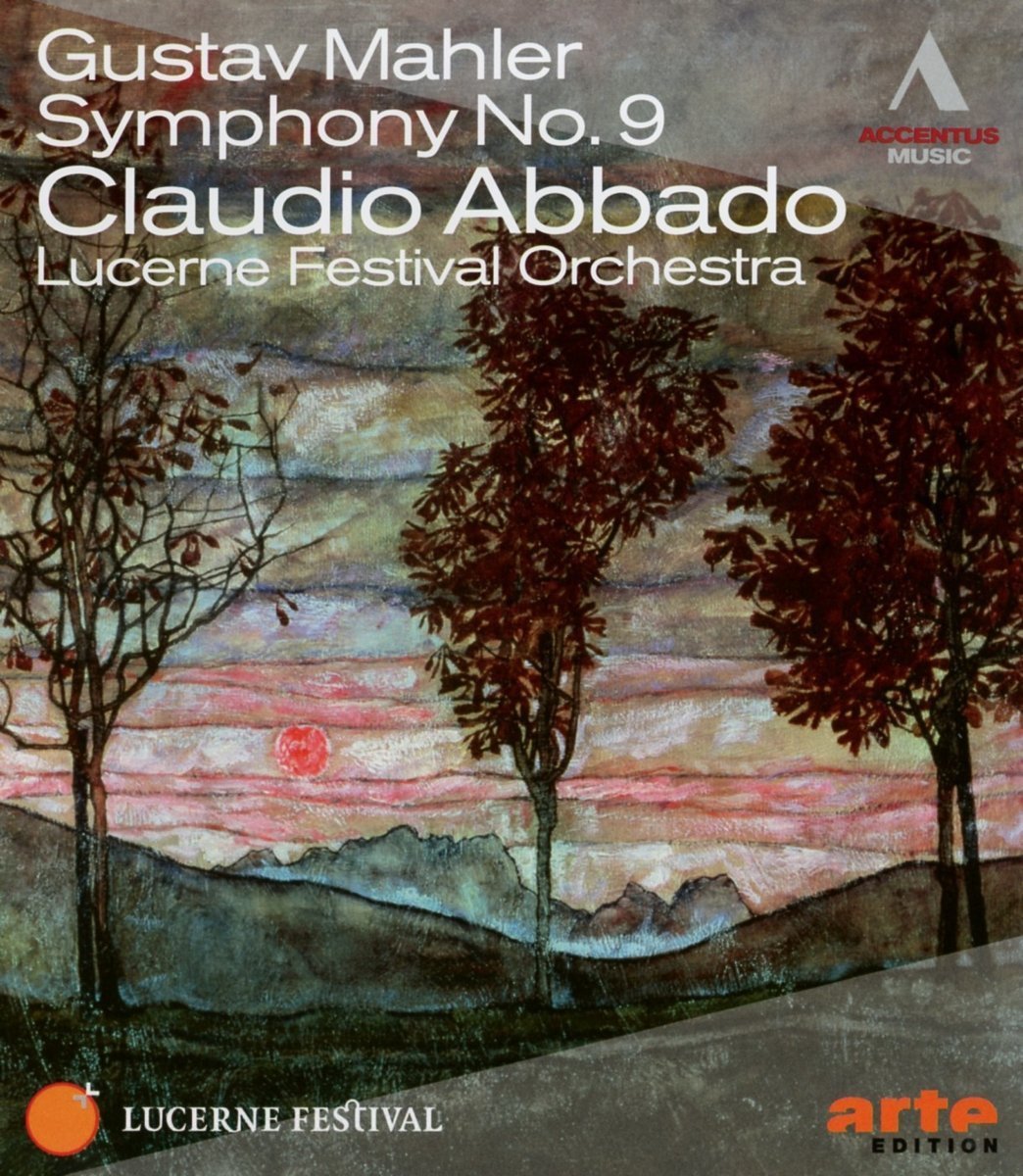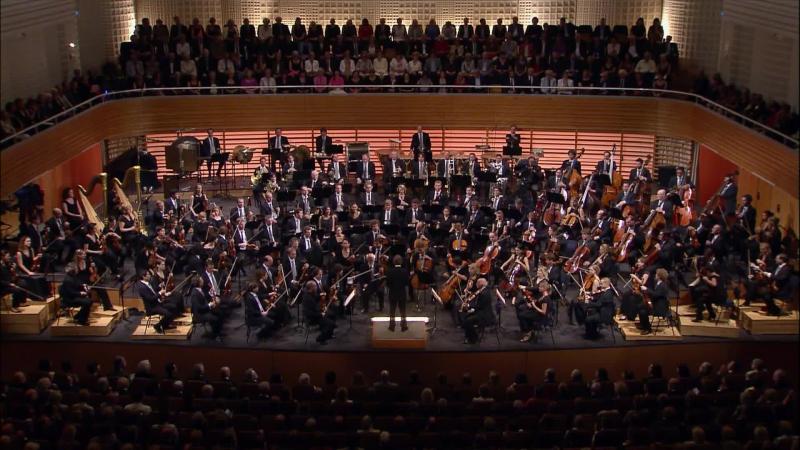

Mahler Symphony No. 9 concert. Claudio Abbado conducts the Lucerne Festival Orchestra in 2010. Directed for TV by Michael Beyer; produced by Paul Smaczny. Released 2011, disc has 5.1 dts-HD Master Audio sound output. This is the first HDVD to have a "multi-angle conductor camera." Grade: D+
This disc has two videos: Angle 1 is the normal view and Angle 2 is a completely different video called the "conductor view." The Angle button on my Oppo BDP-93 works easily to switch between the angles. If you watch Angle 2 straight through, most of the time you see Abbado from the waist up from a camera located on the floor behind and between the Principal Second Violin and the Assistant Principal Second Violin (shooting the conductor from 11:00). From time to time the view shifts briefly to a conductor-over-backs shot. Between the movements, a whole-orchestra shot appears (since Abbado isn't conducting). And there are a few normal views that pop up inexplicably also in Angle 2. So if you like, you can devote your TV screen to watching the conductor, say, 98% of the time the orchestra is playing. Or you can watch the orchestra on Angle 1 and switch to the conductor view any time and stay with the conductor as long as you like.
Paul Smaczny left EuroArts and started the Accentus label. The last EuroArts disc in the Lucern Festival Mahler series was the Symphony No. 7. Subject title was the first Lucerne Festival title for Accentus. ( A Lucerne Festival Symphony No. 8 with Abbado was planned but didn't materialize.)
This Lucern Mahler 9 concert made a splash. David Gutman in the June 2011 Gramophone praised the DVD lavishly, and it got an award. Subject title also got a "Diapason d'Or" award from Diapason magazine, a nod from International Classical Music Awards, and an top award from BBC Music Magazine. But you get the impression that none of these fine print critics ever saw the Blu-ray version.
We disagreed with these glowing assessments. Here's what wonk William Huang had to say about this Abaddo Mahler 9 in a piece he called Too Close to Greatness (somewhat edited):
“Reviewers across the Internet rave about the last moments of this concert. Abbado turned down the lights and imposed a time of silence at the end of the symphony. The audience reacted passionately. That is perhaps the disc's only virtue above other live accounts of Mahler 9 captured on film.
Those who lauded this disc didn't use their eyes as carefully as their ears. A typical example is Gramophone critic David Gutman's dense, meandering account on the interpretative virtues of this disc, but which fails completely to ask—should we watch it?
The sound here compares favorably with other decent recordings of Mahler 9, but this is a video. Creating any professional video means filling more requirements than producing a high-fidelity audio recording. It requires even more thought and planning. Watching this particular video told me that the camera team led by Michael Beyer either does not know what to do with Blu-ray technology, or has no faith in it. It's filmed the same way as someone would film a concert in the seventies, or eighties, or nineties. In grand, outpouring tuttis, the director uses hideous panoramic shots that give us generous views of the musicians' scores and their backsides, but seldom shows how they actually perform.
Overall, the camera direction uses a routine, dreary style that switches angles from musician to musician. Sometimes it features one of the cellists, sometimes a horn player, sometimes a woodwind player, or just Abbado. Once in a while you see Natalia Gutman (one of Rostropovich's finest pupils) or legendary Clarinetist Sabine Meyer. These kinds of angles at high resolution only show us how much make-up some musicians use. Alas, we only get glimpses of the greatness of their collaborative art.
There is some terrific playing here, and it's recorded quite well so that one can hear many layers of sound. But it's bizarre to watch. Mahler's melodies and harmonies often involve different instrumentalists and multiple sections. Unlike DVDs, the high-resolution of Blu-Ray video has the power to show a large number of musicians clearly without making them look tiny or blurring their physical movements. So it's really weird when, for example, you see only one horn player but also hear other rich textures that involve the strings and woodwinds.
By segregating one or two musicians for each camera angle, the director also heightens (or hides) the lack of synergy in the Lucerne Festival Orchestra, excellent as each player is. The distinguished musicians in this video meet only once a year for three weeks—otherwise, due to their busy schedules, most of them are almost strangers to one another. Listen to any of Abbado's most fantastic recordings with full-time orchestras from Berlin or Vienna. One can sense that the players in these ensembles know one another very well. You can see the teamwork that occurs in a good orchestra, with each musician in the Concertgebouw preparing or encouraging each other during the concert.
To those in the audience, this was an exceptional event. But the conventional, outdated camera work makes this production another casualty/lost opportunity in the long history of poorly filmed great concerts. It's mind boggling that after nearly a century of directors experimenting with every single camera angle possible, this production team chose the most bland, irrelevant close-ups. Why did they do this when they were armed with such powerful equipment? Was the camera team so overwhelmed by the power of this ideal ensemble that they could only bear to film one person at a time? Why bother then to use such expensive audio recording equipment to capture virtually every sound? Why not record it in mono?
Despite this disc’s abundant flaws, it might be, with its "Conductor Camera" a useful document for teaching conductors. But no matter how great the conductor, the whole magic of a great symphonic performance requires seeing all the players involved and not just a string of tiny fragments of the whole.”
Later William boiled down his thinking to what became "Huang's Law": A good HDVD shoot will, "Use the flexible power of the HD camera to get a pleasant (not hyperactive) mixture of shots of solos, small groups, small sections, large sections, and even groups of sections as well as the whole orchestra—depending on what forces the composer commits at various places in the score."
Well let's break up all this text with some screenshots. Our first picture shows the orchestra at rest just before the beginning of the concert. As is typical for a video shot in 2010, the resolution is a bit soft. The lights remain low for the whole symphony, which further challenges the video team:
This shot below would be a decent part-orchestra view, except that it's a tad too low. The players at the edge of the stage block the view of players sitting further back:
Here a nice part-orchestra view:
And next below is a part-orchestra shot of all the lower strings:
I count 16 cellos. Here's a decent shot with clear views of 11 cellos. The color balance is pleasant. But this view cuts the principal chairs in half:
The slightly better shot below gets the principals in view but only has 9 instruments clearly in the frame:
To get all the cellos in a frame, the camera must move back, but here it has moved back too far to focus just on that section:
Here's a pretty shot of the back ranks of the 1st and 2nd violins:
A small section angle of the muted trombones:
A solo shot of Sabine Meyer showing the fierce devotion required to a principal in a great orchestra:
Below is one of 27 instrument-only shots. The harps have an important role in this symphony, but the TV director didn't have any way to put the musicians in a frame. This was the best he could do:
One of 71 shots showing the conductor over the backs (C/B) of musicians:
There were also 121 shots of the front of the conductor. With 192 conductor shots in total, quite a few "twisted sisters" views appear, i.e., a conductor shot and a C/B shot (or vice versa) that appear one after the other in the video. And there were even several "ménage à trois" shot events such as the one shown in the next 3 screenshots. First, at about 30:54, comes a conductor shot:
The conductor shot is followed at about 31:03 by the C/B shot below:
And for the next shot at about 31:11, we are back to the solo conductor. How creative!
Here are the video clip statistics on this recording:
Conductor clips = 121
C/B clips = 71
Solos, small section, small group clips = 280
*Large section, large group clips = 20
*Part orchestra clips = 17
*Whole orchestra clips = 12
Instrument only clips = 27
There's a total of 548 clips over 84 minutes of music, which yields a pace of 9.2 seconds per clip. There are 49 supershots (marked with "*") above, so only 9% of the total clips in the video are large-scale shots. There are 192 total conductor shots, which is 35% of total clips.
We have established the follow rules-of-thumb to identify a Blu-ray with DVDitis:
“A good symphony HDVD should have a slow pace with more than 10 seconds per video clip on average. 20 to 40% of the clips should be large-scale "supershots." Conductor shots should be less than 20% of the clips in the video.”
Subject title flunks all three tests and has a roaring case of DVDitis. This title is a DVD republished in Blu-ray livery with somewhat better PQ and SQ (perhaps).
It is especially ironic that this title should have 192 conductor shots when it is also published with the Angle 2 conductor video on board. The consumer can see easily all the conductor views he wants by going to Angle 2. So why force 192 conductor views on the consumer in Angle 1 presentation? The answer is that DVDs of symphonies always have tons of conductor shots. No effort was make by the producers of subject title to take advantage of the special capabilities of HD video. Subject title was rendered obsolete and defective before the TV crews could pack up and leave the concert hall. So why did this happen? My best guess is that the demand for Blu-ray symphony discs was too small in 2010 to justify paying attention to taking full advantage of HD TV.
So what grade for this? This was probably an A+ performance. For soft resolution, I reduce the grade to A-. For devastating DVDits I reduce the grade 2 letters to C-. The print critics liked the recording and SQ, but I heard too much muddiness in the recorded sound to please me. So I wind up with a D+ for a title that appeared to be an industry favorite. Well, I think the awards this got were from folks who knew a little about DVDs and nothing about HDVDs. I'll stick with the D+, which means avoid the title unless you have a real good reason to buy it (which could include a sentimental interest in Abbado nearing his death). This title was maybe a reasonable buy when compared to the past. But now with 4-K video just around the corner, subject title has no future.
OR















